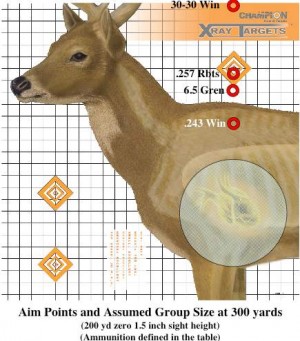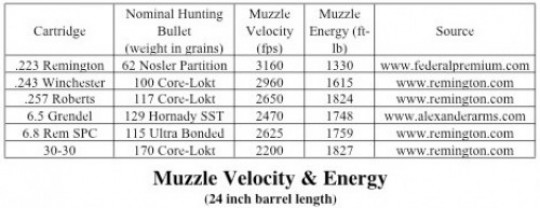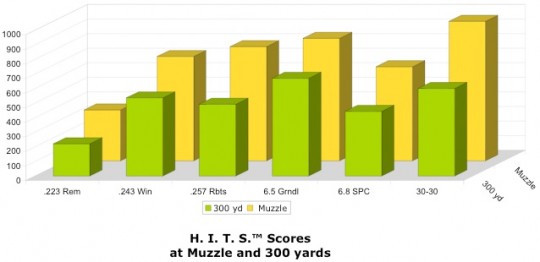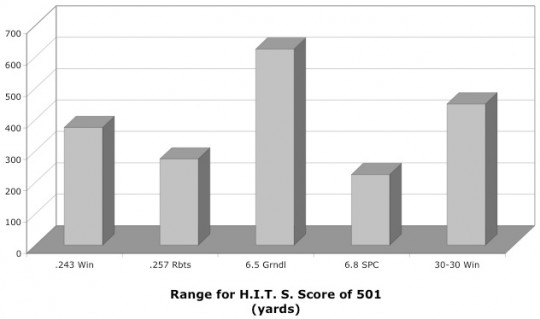| Why the Fuss over Grendel? | Potential for Large Game | Holdover and Aim Points |

While most game is taken at surprisingly short ranges, we all like the idea of being able to reach out and touch our quarry pretty much out to our ability to see it with the unaided eye. Shooting skills are the principal range limiter provided the rifle, cartridge, & bullet are up to the task. We can use these considerations to explore the potential of the 6.5 Grendel™ as a potentially effective medium game cartridge while still using the same lower receiver as is used in the standard service rifle.
Most occasional shooters are very pleased when their group size approaches 1 inch at a 100 yards. The additional stresses of awkward positions, adrenaline from the hunt excitement, fatigue from getting to the shooting point, range estimation uncertainties, and so on mean that we would be well-advised to plan on our actual field-conditions group size growing to about 3 inches at 100 yards.
The vital zone for deer-sized game is about 10 inches. A 100-yard group size of 3 inches grows to almost 10 inches at 300 yards. This means that most of us should shoot at ranges of less than about 300 yards to be more confident in attaining hits in the vital zone. Planning to take game at greater distances should wait until we have done the additional practice and obtained the necessary field experience to have high confidence of solid hits at greater ranges.
The task of assuring a solid hit over this distance is made easier because all but one of the cartridge and bullet combinations should be able to connect with the vital zone with at most a modest holdover for a deer-sized target at 300 yards when using a 200 yd zero. The author is indebted to Champion Targets (www.championtarget.com) for creating a life-size target with vital organs displayed along with dimension lines. The holdover needed for a heart shot using several of the cartridges discussed is illustrated on a depiction of the Champion Xray™ Target.
We see immediately that the holdover needed for the 30-30 with classic ammunition makes precise aiming a challenge. The flat-shooting .243 Winchester has the most convenient aim point at 300 yards, with both the classic .257 Roberts and the 6.5 Grendel™ showing holdovers that are comparatively easily judged. Another way of looking at the issue, placing the cross-hair at the top of the deer’s back with maybe a cross-hair’s width of daylight showing gives a good sight picture. The resulting additional aiming errors are likely well within the posited nine-inch group at this range. These aiming uncertainties are part of the logic leading to the notion that this group size is what we should expect under realistic hunting conditions.

We also know from many writers and terminal ballistics experts that we need to consider more than muzzle velocity and energy when assessing cartridge adequacy. While a number of techniques for the assessment have been published, the Hornady H.I.T.S.™ calculator, accessible at http://www.hornady.com/ appears to be one of the most comprehensive tools available and is very easy to apply. This online tool takes into consideration Bullet Weight, Sectional Density, and Impact Velocity and yields a numerical rating that can be compared to 4 game classes.

See comments at bottom of page
A H.I.T.S.™ rating of 500 or below suggests that the bullet and impact velocity is suitable for small game, while a rating of 501 to 900 makes the combination applicable to medium game weighing 50 to 300 pounds. Examples of medium game are deer, antelope, black bear and caribou. Ratings of 901 to 1600 make the bullet and impact velocity combination applicable to non-dangerous game in the weight class of 300 to 2000 pounds. The web site suggests that a H.I.T.S.™ rating above 1500 is indicated for hunting dangerous game, regardless of weight.
Our discussions centered on medium-sized game so we look for a rating above 500. We learn from the yellow columns in the figure above that the H.I.T.S.™ rating of about 350 for the .223 at muzzle velocity does not meet the medium game standard set by Hornady. The remaining five ratings easily meet the standard at the muzzle, with the 30-30 rating of 957 easing it into the large-game category for extremely short ranges. This helps explain its continuing popularity over more than a century of use.

The picture changes slightly at 300 yards. The 300-yard ratings show that the .243, (536) the 6.5 Grendel (670), and the 30-30 (601) readily meet the standard. The .257 Roberts using classic bullets comes very close with a rating of 492. The lighter, larger diameter bullets of the 6.8 slow down faster, resulting in maximum H.I.T.S.™ range of 225 yards even though the cartridge is a very effective military round. One conclusion that may be drawn is that both the 30-30 with classic ammunition and the 6.8 SPC are likely good medium game cartridges at ranges under about 250 yards but for different reasons. We also see that the excellent drag characteristics of modern bullets help the 6.5 Grendel attain the highest H.I.T.S.™ rating (670) at this range even though it was slightly behind the 30-30 rating at the muzzle.
The figure showing maximum range for a H.I.T.S.™ rating of at least 501 helps those of us who believe we can shoot accurately enough to regularly hit the 10-inch vital zone at the longer ranges. This chart shows that the 6.5 Grendel easily outranges the classic lightweight deer cartridges by a significant margin with medium game potential to beyond 600 yards. In fairness to the .243 and the .257, bullets of modern design would improve their capability in the H.I.T.S.™ sense, but the Grendel™ remains impressive — particularly since this performance is on effectively the same platform as the 5.56 NATO!
###
Acknowledgements: This article would have been a lot less interesting and more confusing without the excellent advice and encouragement from Charlie Cutshaw, Alane Alchorn, and Randy Collins. Charlie in particular brought reports of recent combat experiences with the Mk262 to my attention. Thank you!
| Why the Fuss over Grendel? | Potential for Large Game | Holdover and Aim Points |

 sending...
sending...
A reader has correctly pointed out that the .257 Roberts performance is substantially improved when modern powders and bullets in handloads are used. Some of these handloads are impressive in that they outperform some factory loads in the 25-06!
Comparing modern factory loads between the .257, 6.5 Grendel, and the 30-30, however, suggests that the HITS scores at 300 yards are nearly equal, with the .257 and Grendel enjoying about a 3% higher score than modern factory loads with the 30-30.
Returning to the HITS chart, it correctly indicates relative performance of the cartridges shown when standard velocity loads are used. These were the only factory loads available fifty years ago during the time that the .243 Win, .257 Roberts, and 30-30 were considered to be among the best medium power deer cartridges. The AR-15 compatible 6.5 Grendel compares very favorably with these classic cartridges.